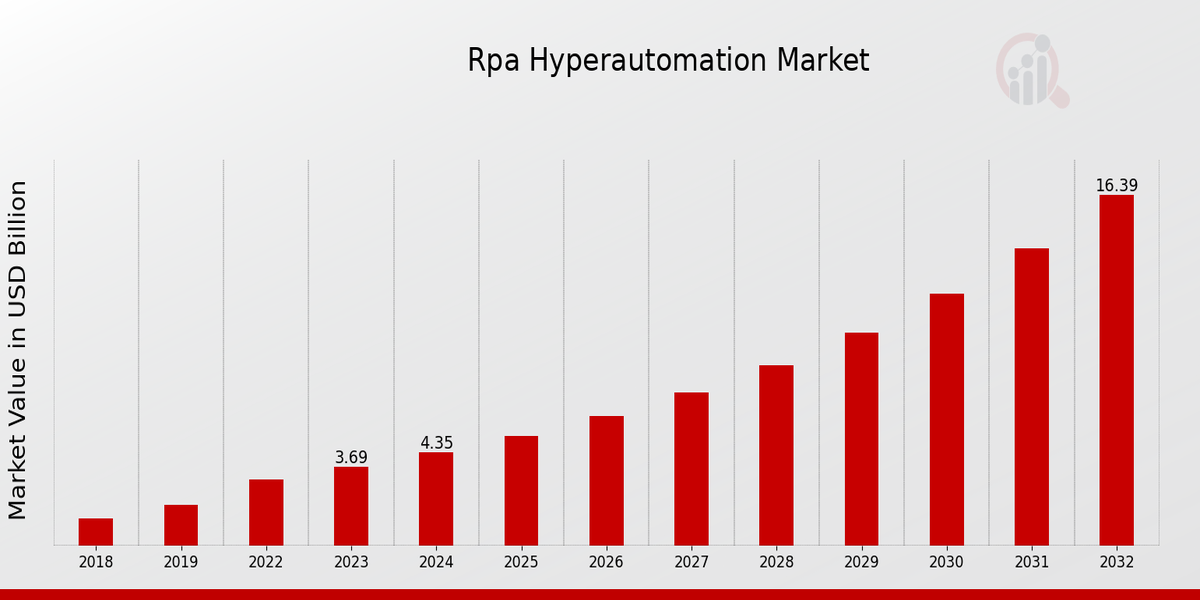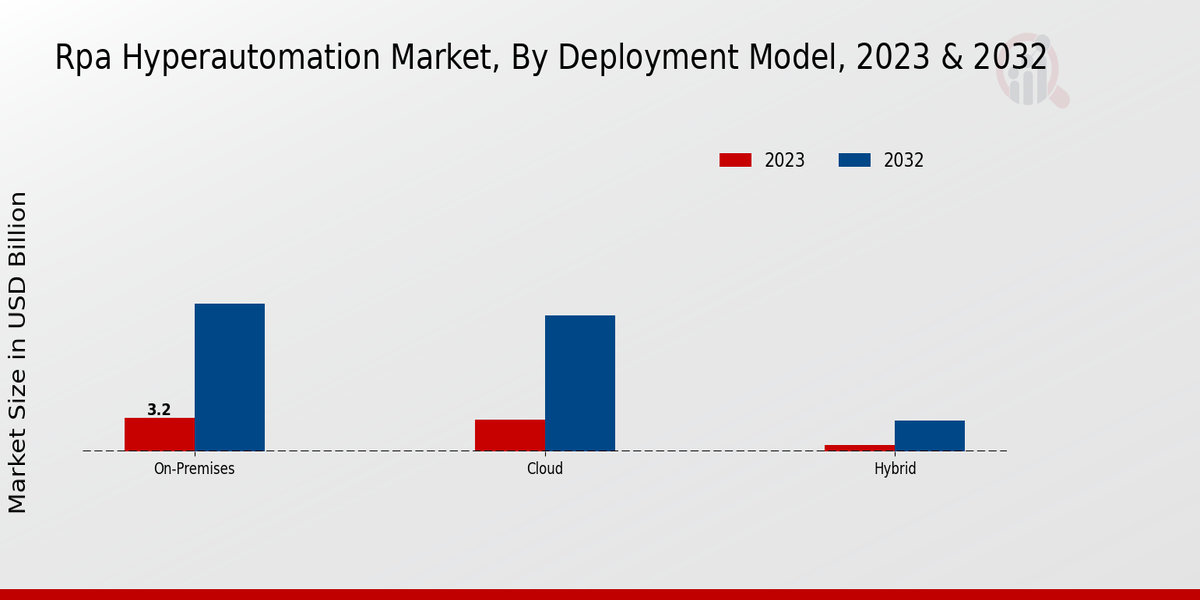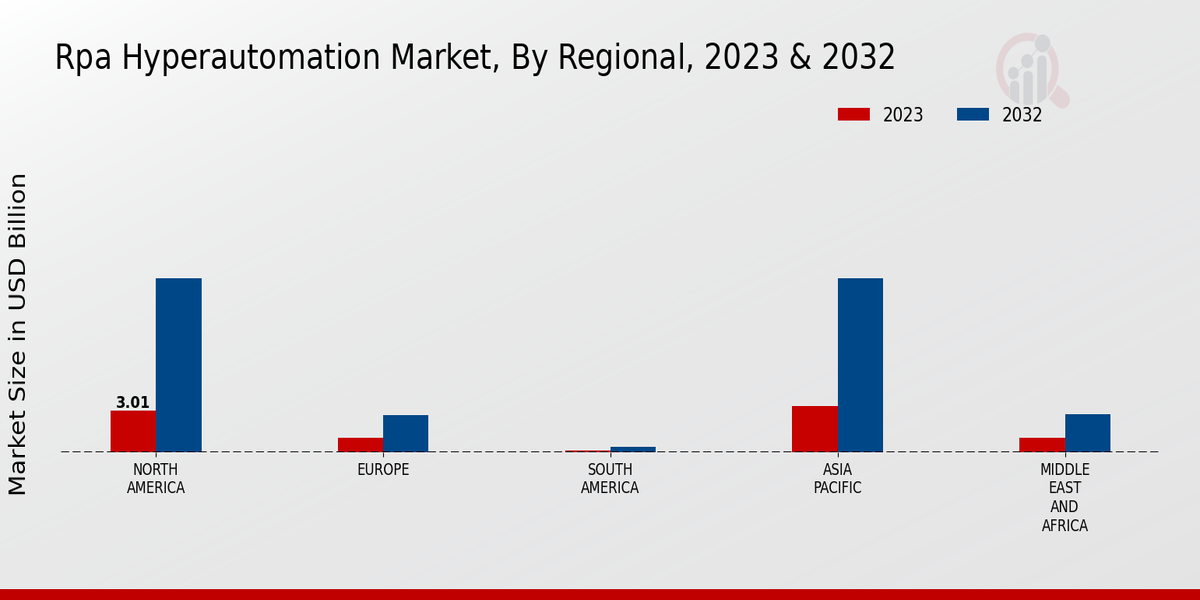RPA Hyperautomation Market Overview
RPA Hyperautomation Market is projected to grow from USD
6.55 Billion in 2025 to USD
26.92 Billion by 2034, exhibiting a compound annual growth rate (CAGR) of 18.32% during the forecast period (2025 - 2034). Additionally, the market size for RPA Hyperautomation Market was valued at USD 5.13 billion in 2024.
Key RPA Hyperautomation Market Trends Highlighted
Key market drivers for RPA hyperautomation include the rising need for business process automation, increasing adoption of cloud-based solutions, and growing awareness of the benefits of hyperautomation. Additionally, the advent of artificial intelligence (AI) and machine learning (ML) is further fueling the adoption of RPA hyperautomation solutions.
Opportunities in the RPA hyperautomation market lie in the expansion into new industries, development of industry-specific solutions, and the integration of AI and ML capabilities. The trend towards remote work and the increasing demand for digital transformation are also creating new opportunities for RPA hyperautomation solutions.
Recent trends in the RPA hyperautomation market include the rise of low-code/no-code platforms, the emergence of intelligent automation, and the increasing focus on customer experience. The rise of low-code/no-code platforms is simplifying the implementation of RPA hyperautomation solutions, making them more accessible to organizations of all sizes. Intelligent automation is enabling RPA hyperautomation solutions to automate more complex tasks, and the focus on customer experience is driving the development of solutions that are tailored to the specific needs of businesses.
 Source: Primary Research, Secondary Research, MRFR Database and Analyst Review
Source: Primary Research, Secondary Research, MRFR Database and Analyst Review
RPA Hyperautomation Market Drivers
-
Increasing Adoption of Cloud-Based RPA Solutions
The rising adoption of cloud-based RPA solutions is a major market driver for the Global RPA Hyperautomation Market Industry. Cloud-based RPA eliminates the need for on-premises infrastructure, making it easier for businesses to implement and scale their RPA initiatives. This has led to a significant increase in the adoption of RPA solutions, particularly among small and medium-sized enterprises. Additionally, cloud-based RPA solutions offer several advantages, such as increased flexibility, scalability, and cost-effectiveness.These factors are expected to continue to drive the growth of the Global RPA Hyperautomation Market Industry in the coming years.
Growing Demand for Automation in Various Industries
The increasing demand for automation in various industries is another key market driver for the Global RPA Hyperautomation Market Industry. RPA solutions can be used to automate a wide range of tasks across industries, including healthcare, manufacturing, retail, and financial services. As businesses look to improve efficiency, reduce costs, and enhance customer service, the demand for RPA solutions is expected to continue to grow. The versatility and adaptability of RPA solutions make them a valuable tool for businesses of all sizes and industries.
Technological Advancements and Innovation
Rapid technological advancements and innovation are also driving the growth of the Global RPA Hyperautomation Market Industry. The development of new technologies, such as artificial intelligence (AI) and machine learning (ML), is enhancing the capabilities of RPA solutions. These technologies enable RPA solutions to automate more complex tasks and processes, making them even more valuable to businesses. Additionally, the integration of RPA solutions with other enterprise applications and systems is improving their interoperability and effectiveness.
RPA Hyperautomation Market Segment Insights
-
RPA Hyperautomation Market Deployment Model Insights
The Global RPA Hyperautomation Market is segmented based on deployment model into on-premises, cloud, and hybrid. Among these, the cloud segment is expected to hold the largest market share during the forecast period. The increasing adoption of cloud-based solutions due to their scalability, flexibility, and cost-effectiveness is driving the growth of this segment. The cloud deployment model enables businesses to access RPA hyperautomation solutions without the need for upfront infrastructure investments. Additionally, the cloud provides access to advanced features such as artificial intelligence (AI) and machine learning (ML), which can enhance the efficiency and accuracy of RPA hyperautomation processes.
The on-premises deployment model is expected to hold a significant market share during the forecast period. This deployment model offers greater control and security over data and processes, which is preferred by enterprises with sensitive or confidential data. However, the on-premises deployment model requires significant upfront infrastructure investments and ongoing maintenance costs. The hybrid deployment model combines the advantages of both on-premises and cloud deployment models. This model allows enterprises to deploy RPA hyperautomation solutions on-premises for critical processes while leveraging the cloud for non-critical processes.
The hybrid deployment model provides flexibility, scalability, and cost optimization. Overall, the Global RPA Hyperautomation Market is expected to witness significant growth in the coming years, driven by the increasing adoption of cloud-based solutions, the need for process automation, and the growing demand for AI and ML-powered solutions.
 Source: Primary Research, Secondary Research, MRFR Database and Analyst Review
Source: Primary Research, Secondary Research, MRFR Database and Analyst Review
RPA Hyperautomation Market Process Automation Type Insights
The Global RPA Hyperautomation Market is segmented based on Process Automation Type into Front Office, Back Office, and Middle Office. Among these segments, the Front Office segment is expected to hold the largest market share in 2023, owing to the increasing adoption of RPA solutions to automate customer-facing processes such as sales, marketing, and customer service. The Back Office segment is also expected to witness significant growth in the coming years, as businesses seek to automate back-end processes such as finance, accounting, and supply chain management. The Middle Office segment is expected to grow at a steady pace, as businesses look to automate processes that connect the front and back office, such as risk management and compliance.
RPA Hyperautomation Market Industry Vertical Insights
The Global RPA Hyperautomation Market is segmented based on industry vertical into Banking and Financial Services, Healthcare, Manufacturing, Retail, and Telecommunications. Among these segments, Banking and Financial Services is expected to hold the largest market share in 2023, owing to the increasing adoption of RPA and hyperautomation technologies by banks and financial institutions to streamline operations, reduce costs, and improve customer service. The Healthcare segment is also expected to witness significant growth in the coming years due to the rising demand for automation in healthcare processes such as patient record management, claims processing, and drug discovery.
The Manufacturing segment is another key vertical for the RPA Hyperautomation Market, as manufacturers are increasingly seeking ways to improve efficiency and productivity through automation. The Retail and Telecommunications segments are also expected to contribute to the growth of the RPA Hyperautomation Market over the forecast period.
RPA Hyperautomation Market Company Size Insights
The Global RPA Hyperautomation Market is segmented by company size into large enterprises and small and medium-sized enterprises (SMEs). Large enterprises are expected to hold a larger market share due to their significant investments in digital transformation initiatives and the need to improve operational efficiency. SMEs are also expected to contribute to the market growth as they increasingly adopt RPA Hyperautomation solutions to streamline their operations and gain a competitive advantage. The Global RPA Hyperautomation Market for large enterprises is projected to reach USD 11.4 billion by 2024, while the market for SMEs is expected to reach USD 5.0 billion by the same year.
RPA Hyperautomation Market Regional Insights
The Global RPA Hyperautomation Market is segmented into North America, Europe, APAC, South America, and MEA. North America held the largest market share in 2023 and is expected to continue its dominance throughout the forecast period. The growth in this region can be attributed to the presence of large enterprises and the early adoption of advanced technologies such as RPA and hyperautomation. Europe is the second-largest market for RPA Hyperautomation, followed by APAC. The APAC region is expected to witness the fastest growth rate during the forecast period, owing to the rapid digitization of businesses and the increasing demand for automation solutions. South America and MEA are relatively smaller markets for RPA Hyperautomation but are expected to grow at a steady pace in the coming years.
 Source: Primary Research, Secondary Research, MRFR Database and Analyst Review
Source: Primary Research, Secondary Research, MRFR Database and Analyst Review
RPA Hyperautomation Market Key Players And Competitive Insights
Major players in RPA Hyperautomation Market industry are continuously striving to develop advanced technologies to gain a competitive edge. Leading RPA Hyperautomation Market players are focusing on strategic partnerships, acquisitions, and collaborations to expand their market presence. The RPA Hyperautomation Market development is driven by the increasing adoption of artificial intelligence (AI) and machine learning (ML) technologies, which enable RPA solutions to automate complex and repetitive tasks. The RPA Hyperautomation Market Competitive Landscape is expected to remain highly competitive, with new entrants and established players continuously innovating to meet the evolving needs of customers.
UiPath is a leading provider of RPA and hyperautomation solutions. The company offers a comprehensive suite of products and services that enable organizations to automate a wide range of business processes. UiPath has a strong global presence and serves a diverse customer base across various industries. The company has a strong track record of innovation and has been recognized as a leader in the RPA market by leading industry analysts. UiPath is committed to providing its customers with the latest and most advanced RPA and hyperautomation solutions to help them improve their operational efficiency and achieve their business goals.
Blue Prism is a leading provider of RPA software. The company's software is used by organizations around the world to automate a wide range of business processes, including customer service, order processing, and financial reporting. Blue Prism has a strong focus on providing its customers with a comprehensive and easy-to-use RPA solution. The company's software is designed to be scalable and can be deployed on-premises or in the cloud. Blue Prism has a strong track record of success and has been recognized as a leader in the RPA market by leading industry analysts.
Key Companies in the RPA Hyperautomation Market Include
-
Google
-
Oracle
-
Pegasystems
-
Automation Anywhere
-
NICE
-
Kofax
-
SAP
-
Microsoft
-
IBM
-
WorkFusion
-
ServiceNow
-
Kryon Systems
-
Blue Prism
-
UiPath
-
Redwood Software
RPA Hyperautomation Market Industry Developments
The RPA hyperautomation market is projected to grow significantly in the coming years, reaching a market valuation of USD 16.4 billion by 2032, exhibiting a CAGR of 18.03% from 2024 to 2032. This growth can be attributed to the increasing adoption of RPA and hyperautomation technologies across various industries. Recent news developments include the acquisition of Laiye by Salesforce, which is expected to strengthen Salesforce's position in the RPA market. Additionally, UiPath's partnership with Microsoft to integrate its RPA platform with Microsoft Azure is expected to drive growth in the cloud-based RPA market.
RPA Hyperautomation Market Segmentation Insights
-
RPA Hyperautomation Market Deployment Model Outlook
-
RPA Hyperautomation Market Process Automation Type Outlook
-
Front Office
-
Back Office
-
Middle Office
-
RPA Hyperautomation Market Industry Vertical Outlook
-
Banking and Financial Services
-
Healthcare
-
Manufacturing
-
Retail
-
Telecommunications
-
RPA Hyperautomation Market Company Size Outlook
-
Large Enterprises
-
Small and Medium-sized Enterprises (SMEs)
-
RPA Hyperautomation Market Regional Outlook
-
North America
-
Europe
-
South America
-
Asia Pacific
-
Middle East and Africa
|
Report Attribute/Metric
|
Details
|
|
Market Size 2024
|
5.13 (USD Billion)
|
|
Market Size 2025
|
6.55 (USD Billion)
|
|
Market Size 2034
|
26.92 (USD Billion)
|
|
Compound Annual Growth Rate (CAGR)
|
18.32% (2025 - 2034)
|
|
Report Coverage
|
Revenue Forecast, Competitive Landscape, Growth Factors, and Trends
|
|
Base Year
|
2024
|
|
Market Forecast Period
|
2025 - 2034
|
|
Historical Data
|
2019 - 2023
|
|
Market Forecast Units
|
USD Billion
|
| Key Companies Profiled |
Google, Oracle, Pegasystems, Automation Anywhere, NICE, Kofax, SAP, Microsoft, IBM, WorkFusion, ServiceNow, Kryon Systems, Blue Prism, UiPath, Redwood Software |
| Segments Covered |
Deployment Model, Process Automation Type, Industry Vertical, Company Size, Regional |
| Key Market Opportunities |
1 AIpowered selfhealing RPA2 Integration with cognitive automation3 Hyperautomation as a managed service4 RPA in cloudnative environments5 RPA for edge computing |
| Key Market Dynamics |
Rising automation adoption cloudbased deployment model cognitive intelligence integration growing demand for enhanced operational efficiency increasing government initiatives and regulatory support |
| Countries Covered |
North America, Europe, APAC, South America, MEA |
Frequently Asked Questions (FAQ) :
The global RPA Hyperautomation Market is expected to reach USD 26.92 billion by 2034, growing at a CAGR of 18.03% from 2023 to 2034
North America is expected to hold the largest market share in the global RPA Hyperautomation Market during the forecast period.
The key growth drivers of the global RPA Hyperautomation Market include the increasing adoption of automation technologies, the growing need for operational efficiency, and the rising demand for cost-effective solutions.
The major applications of RPA Hyperautomation in the global RPA Hyperautomation Market include customer service, IT operations, finance and accounting, and supply chain management.
The key competitors in the global RPA Hyperautomation Market include UiPath, Automation Anywhere, Blue Prism, Microsoft, and IBM.
The global RPA Hyperautomation Market is expected to reach USD 3.69 billion in 2023.
The global RPA Hyperautomation Market is expected to grow at a CAGR of 18.03% from 2023 to 2034
The banking, financial services, and insurance (BFSI) industry is expected to have the highest demand for RPA Hyperautomation solutions.
The challenges faced by the global RPA Hyperautomation Market include the lack of skilled professionals, the need for robust infrastructure, and the high cost of implementation.
The opportunities for growth in the global RPA Hyperautomation Market include the increasing adoption of cloud-based RPA solutions, the growing demand for cognitive automation, and the emergence of new applications in various industries.

















